
Elevating Healthcare Excellence: The Role of NABH in Transforming Hospitals
Introduction:
Dive into the world of NABH, the cornerstone of healthcare quality and patient safety in India. Established to propel healthcare institutions towards global standards, NABH accreditation is not just a benchmark but a continuous journey towards excellence in healthcare delivery.
The Journey to NABH Accreditation: A Step-by-Step Guide
The NABH accreditation process is a meticulous journey towards quality improvement. From the initial application to meeting the entry-level checklist and adhering to NABH guidelines, each step is designed to enhance the hospital's operational and clinical outcomes.
The Core of NABH: Ten Chapters of Hospital Standards
NABH standards for hospitals are comprehensive, covering all aspects of healthcare delivery. From patient rights and education to hospital infection control and management of medication, these standards ensure that hospitals operate at the highest level of efficiency and patient care.
Access, Assessment and Continuity of Care (AAC): Ensures patients have timely access to care and proper assessment.
Care of Patients (COP): Focuses on the actual treatment and care provided to patients.
Management of Medication (MOM): Ensures safe and effective use of medications.
Patient Rights and Education (PRE): Upholds patient rights and focuses on patient education.
Hospital Infection Control (HIC): Aims to prevent and control infections within the hospital.
Patient Safety and Quality Improvement (PSQ): Focuses on overall patient safety and continuous quality improvements.
Responsibilities of Management (ROM): Involves the overall responsibilities of hospital management.
Facilities Management and Safety (FMS): Ensures the safety and adequacy of hospital facilities.
Human Resource Management (HRM): Manages all aspects of human resources in a hospital.
Information Management System (IMS): Involves the management of patient and hospital information.
The Multifold Benefits of NABH Accreditation
Accreditation brings numerous advantages, enhancing patient safety, ensuring quality care, and boosting the hospital's reputation. For patients, it means receiving care that meets stringent quality benchmarks, leading to better clinical outcomes.
Patient Safety: Implementati of accreditation standards ensures patient safety and commitment to quality care.
Increased Community Confidence:Accreditation improves patient satisfaction and increases community confidence in healthcare services.
Competitive Advantage:Accreditation status provides a marketing advantage in the competitive healthcare landscape.
International Recognition:NABH standards are recognized internationally, boosting medical tourism.
Objective Empanelment:Provides an objective system of empanelment by insurance and other third parties. hospital.
Eligibility Criteria: Who Can Embark on the NABH Journey?
NABH accreditation is open to healthcare organizations committed to quality improvement and compliance with NABH standards. This section will delve into the eligibility criteria, helping institutions understand how they can begin their accreditation journey.
Financial Investment: Understanding the Costs of NABH Accreditation
Investing in NABH accreditation involves certain costs, but the long-term benefits of improved patient care and operational efficiency far outweigh the initial financial outlay. This section will break down the fee structure, helping hospitals plan their investment in quality improvement.
Empowering Healthcare Providers with NABH Training Programs
NABH offers extensive training programs to equip healthcare providers with the knowledge and tools needed for successful accreditation. From online resources to in-depth workshops, these programs are designed to support healthcare institutions on their path to excellence.
Accessing NABH Standards and Guidebooks
For healthcare institutions embarking on the accreditation journey, accessing NABH standards and guidebooks is the first step. These resources provide a blueprint for aligning hospital operations with best practices in patient care and safety.
Super Dr: A Technological Ally in Meeting NABH Standards
Discover how Super Dr, with its advanced healthcare management features, can help hospitals align with NABH standards, streamline operations, and enhance patient care, making the accreditation journey smoother and more efficient.
NABH Protocols and Standards: Enhancing Hospital Operations
The Significance of Code Blue Protocol in NABH Accredited Hospitals
Code Blue protocol is a critical component of NABH standards, outlining emergency procedures for cardiac arrest or medical emergencies. This protocol ensures that hospitals have a systematic response to save lives, highlighting NABH's commitment to patient safety.
Streamlining Care with Indent and Inventory Management
Effective indent management in nursing and inventory control are pivotal in maintaining the efficiency of hospital operations. NABH guidelines advocate for robust systems to manage medical supplies and equipment, ensuring that healthcare providers have the necessary resources at their disposal without any wastage or shortage.
NABH's Approach to Medication Management
The management of medication under NABH standards emphasizes accuracy, safety, and accountability in drug administration. These guidelines ensure that patients receive the correct medication at the right dose and time, minimizing the risk of errors.
The Impact of NABH on Hospital Operations
Accreditation by NABH brings about transformative changes in hospital operations, from streamlined processes and enhanced patient safety protocols to improved record-keeping and inventory management. The emphasis on SOPs and protocols like the Code Blue protocol ensures readiness and efficiency in critical situations.
NABH and Patient Benefits: A Dual Advantage
NABH accreditation offers dual benefits: enhancing hospital reputation and ensuring patient safety and satisfaction. Patients treated in NABH-accredited hospitals are assured of receiving care that meets stringent quality standards.
Super Dr: Complementing NABH Standards in Healthcare Delivery
Discover how Super Dr, with its advanced healthcare management features, aligns with NABH standards to further enhance hospital operations, patient care, and safety protocols, making it an invaluable tool for NABH-accredited hospitals.
Elevating Nursing Care with Quality Indicators
NABH nursing quality indicators are instrumental in assessing and improving the quality of nursing care. These indicators cover various aspects of nursing management, ensuring that patient care is both effective and compassionate.
Operation Theatre Management: Adhering to NABH Guidelines
Operation theatre management is critical in surgical care, and NABH guidelines for OTs ensure that surgical procedures are conducted in a safe, sterile, and efficient environment, minimizing the risk of infections and complications.
Emphasizing Specialized Care in Daycare and Labs
NABH standards extend to daycare services and laboratory operations (NABL for labs), ensuring that even short-term care and diagnostic services adhere to the highest quality standards, enhancing patient safety and care continuity.
"Quality in healthcare is not an accident; it is always the result of intelligent
effort."
- Adapted from John Ruskin.
FAQ’S
What does NABH stand for, and why is it important?
NABH stands for the National Accreditation Board for Hospitals & Healthcare Providers. It's important because it sets a benchmark for the quality of healthcare services, ensuring hospitals adhere to high standards of patient care and safety.
How can hospitals start the NABH accreditation process?
Hospitals can start the NABH accreditation process by conducting a self-assessment against NABH standards, attending NABH training programs, and then applying for accreditation through the NABH website, followed by preparing for and undergoing a comprehensive assessment.
What are the key benefits of NABH accreditation for patients?
The key benefits for patients include enhanced safety, higher quality of care, and improved clinical outcomes. Accreditation ensures that hospitals maintain a patient-centric approach, adhering to strict quality and safety protocols.
How does NABH impact hospital operations and patient care?
NABH positively impacts hospital operations by streamlining processes, implementing best practices, and fostering a culture of continuous improvement. It enhances patient care by prioritizing safety, ensuring ethical practices, and focusing on patient rights and education.
Can technology like Super Dr aid in meeting NABH standards?
Yes, technology like Super Dr can significantly aid in meeting NABH standards by automating and optimizing hospital operations, maintaining electronic health records, ensuring medication management, and enhancing patient safety and care.
How does the Code Blue protocol enhance patient safety in hospitals?
The Code Blue protocol enhances patient safety by providing a clear, rapid response system for life-threatening situations, ensuring immediate and coordinated action by a trained medical team, thereby increasing the chances of patient survival and recovery.
What are the key components of effective inventory control in nursing management according to NABH?
Effective inventory control in nursing management according to NABH includes regular stock audits, maintaining minimum and maximum stock levels, using inventory management software, and training staff on efficient inventory use and management.
How do NABH standards streamline medication management in hospitals?
NABH standards streamline medication management by implementing protocols for prescription, dispensing, administration, and monitoring of medications, reducing errors, ensuring patient safety, and improving therapeutic outcomes.
What does NABH accreditation signify for a hospital and its patients?
NABH accreditation signifies that a hospital meets high standards of quality and safety in healthcare, reassuring patients of the best care. For hospitals, it represents a commitment to excellence and continuous improvement in healthcare delivery.
How can hospitals implement NABH guidelines in operation theatres to improve surgical outcomes?
Hospitals can implement NABH guidelines in operation theatres by ensuring sterile environments, adhering to surgical safety checklists, conducting pre and post-operative assessments, and continuously monitoring and improving surgical practices and outcomes.
What are the first steps to take towards NABH accreditation?
The first steps towards NABH accreditation include understanding NABH standards, conducting a gap analysis to identify areas of improvement, engaging in NABH training programs, and developing an action plan to meet the accreditation requirements.
How can hospitals maintain NABH standards in the long term?
Hospitals can maintain NABH standards in the long term by fostering a culture of quality and safety, engaging in continuous staff training, regularly reviewing and updating protocols and practices, and conducting internal audits to ensure compliance.
What are the common challenges hospitals face during the NABH accreditation process, and how can they overcome them?
Common challenges include resistance to change, resource constraints, and gaps in staff training. Hospitals can overcome these by fostering leadership support, allocating necessary resources, and investing in comprehensive staff training and development.
How does NABH accreditation impact patient satisfaction and hospital reputation?
NABH accreditation positively impacts patient satisfaction by ensuring high-quality, patient-centric care, leading to better clinical outcomes. It enhances hospital reputation by demonstrating a commitment to excellence and adherence to international healthcare standards.
Can small hospitals and clinics benefit from NABH accreditation, and how?
Yes, small hospitals and clinics can benefit from NABH accreditation by improving their healthcare delivery standards, enhancing patient trust and satisfaction, and gaining a competitive edge in the healthcare market through recognized quality assurance.


